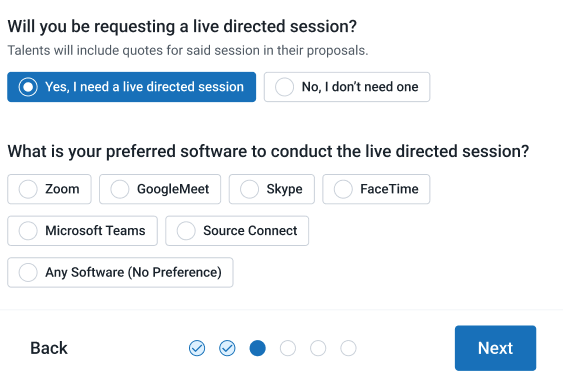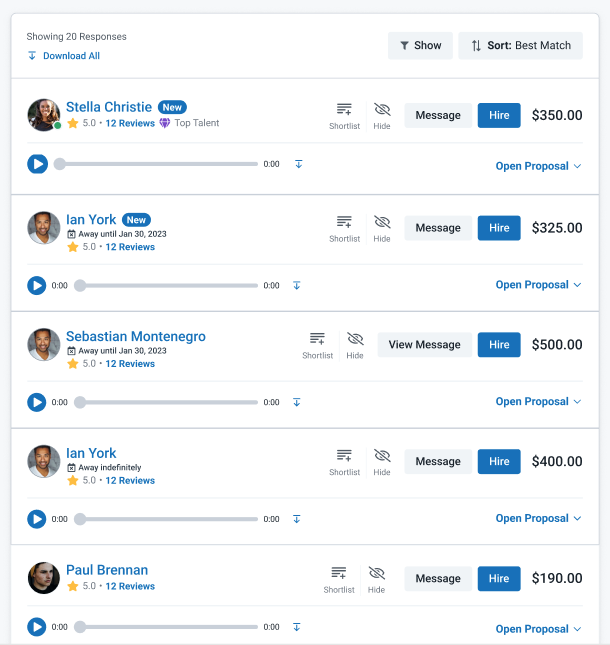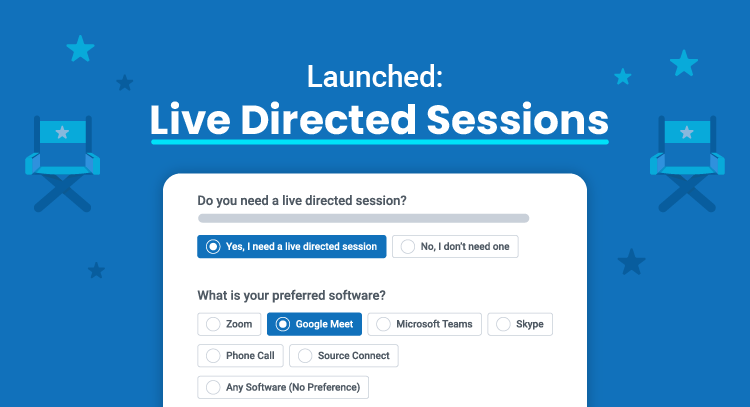In the fast-paced world of voice over, collaboration and real-time communication are key to achieving outstanding results. At Voices, we understand the importance of seamless coordination and effective planning. That’s why we are thrilled to introduce live directed sessions, a feature that will empower you to coordinate real-time recording sessions with the talent directly on our platform.
Seamless Planning Made Easy:
No more juggling schedules or struggling to coordinate with talent. Simply request and plan the sessions directly from our site. With options for some of the most popular conferencing platforms, you’re sure to find the right match for you and your talent.
All Inclusive Pricing:
Talent will quote on the live directed session along with the price of the job. When you are reviewing quotes you will see the full cost, incorporating your live directed session needs, so you can make informed decisions on pricing.
Unparalleled Collaboration:
Provide real-time feedback, guidance and direction to the talent, regardless of your physical location.
How To:
To request a live directed session from the talent, simply select it in the job form. You can choose your favorite video conferencing platform from our list. Remember to not share any personal contact information until you have hired for the job and are ready to conduct the session.

The talent will provide a quote for the overall work – the live directed session and the recording/usage combined. You will see this as a total on the quote.

Once you’ve selected the talent you want to proceed with, simply proceed like you would with any other job on Voices.
Say goodbye to the challenges of scheduling and coordinating with talent as you can now request and plan sessions effortlessly from the Voices platform. Requesting a live directed session is as simple as selecting it in the job form and choosing your preferred conferencing platform. Try it out today and experience the power of live directed sessions to elevate your voice over projects to new heights.

Comments
Hello
I am curious about the fees. I believe my work should be available in paperback, ebook, and audiobook, so I have had books narrated by freelancers. I had a terrible experience last time out. I had to hire an audio engineer to balance it out on top of the narrator fee. In the material up top it quotes $400, $500, and so on. Is the price per hour, or per job? Is the studio engineering and set up included?
Thank you
Cynthia A. King
Hey Cynthia!
Thanks for reaching out! We’re sorry to hear you had a poor experience last time. Having a live directed session would certainly help ensure you’re getting the quality you want.
For non-broadcast work, talent would likely price on a per word basis. Things such as technical requirements, experience of the talent and complexity of the script may change the price. The live directed session would also be quoted in that and put into the overall quote. Most talent have their own studio and do not charge for the set up but it’s ultimately up to the talent you hire. If you have any questions, we’re happy to walk you through to ensure you’re getting the voice over you’re looking for. You can reach out to [email protected].
I have a small, in-home studio- what’s the best way to do a live directed session? Tech set up is the information I’m looking for. Thanks!
Hey Jen,
Here’s a comprehensive list:
1. Essential Hardware
Microphone:
Use a large-diaphragm condenser microphone (e.g., Røde NT1, Neumann TLM 103, Audio Technica AT4047, or Vanguard V4). Avoid USB mics for professional work; XLR mics connected via an audio interface are preferred for superior sound quality.
Audio Interface:
A reliable audio interface (Focusrite Scarlett, Audient iD, PreSonus, etc.) ensures clean signal conversion and low latency.
Headphones:
Closed-back, over-the-ear headphones (Sony MDR-7506, Sennheiser HD280 Pro, Audio Technica ATH-M30x) prevent audio bleed and let you clearly hear direction. Avoid Bluetooth headphones due to latency.
Mic Accessories:
Pop filter to reduce plosives.
Sturdy mic stand or boom arm.
Shock mount to minimize vibrations.
Computer:
A quiet, modern computer (laptop or desktop) with ample RAM and SSD storage. Use a wired Ethernet connection for maximum stability during live sessions.
2. Recording Environment
Acoustic Treatment:
Record in a quiet, sound-treated space. Bedrooms with carpet or walk-in closets lined with clothes work well. Use foam panels, duvets, or blankets to minimize reflections and external noise.
Noise Floor:
Aim for a noise floor of -60dB or lower for professional results.
3. Software & Connectivity
Digital Audio Workstation (DAW):
Use professional software like Pro Tools, Adobe Audition, Reaper, GarageBand (Mac), or Audacity (free). Always record a backup of your session locally.
Remote Connection Software:
Source-Connect Standard/Now: Industry standard for remote, high-quality audio streaming with sync and low latency.
Alternatives: Cleanfeed, ipDTL, or SessionLinkPRO for browser-based connections.
Video Conferencing: Zoom, Skype, or Google Meet for direction and communication (ensure your audio input matches your DAW input for best quality).
4. Session Workflow Tips
Backup Recording:
Always record your own high-quality backup in your DAW. Send the raw file to the client after the session.
Check Your Signal Chain:
Test all gear and connections before the session. Use the same setup you’ll use during the session for your test.
Headphone Monitoring:
If you dislike hearing your own voice, keep one ear uncovered to monitor your natural sound while still hearing the client’s direction.
Internet:
Use a wired Ethernet connection to avoid WiFi dropouts and ensure stable, uninterrupted sessions.
Notifications:
Silence phones and computer notifications to prevent interruptions.
5. Final Checklist Before Your Session
Test all equipment and software.
Confirm your audio input/output settings.
Record a short test and listen for issues.
Ensure your space is quiet and free from interruptions.
Have a backup plan (e.g., install conferencing software on your phone in case of computer issues)